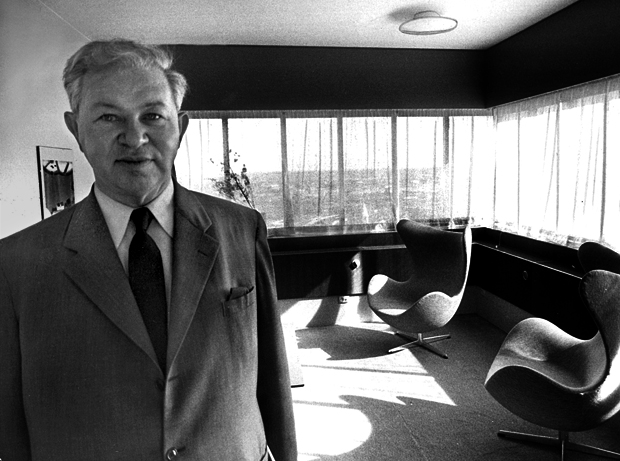
A room with a view
Celebrating 50 years of Arne Jacobsen's SAS House
This year marks the 50th anniversary of the completion of Arne Jacobsen's SAS House in Copenhagen. Michael Sheridan reflects on the vision of the great Nordic architect.
Room 606 is a hotel room and the last remaining interior of Arne Jacobsen’s masterpiece, the SAS House. It is a self-contained world of patterns and contours, and a condensed version of the themes that guided his entire body of work.
Arne Jacobsen was one of those Nordic architects, along with Alvar Aalto, Gunnar Asplund and Kay Fisker, who were trained in Neo-Classicism before modern architecture had really arrived in the North. As a result, they had a particular sensitivity to scale, proportion and contours that gives the work an especially humanistic character. In fact, it was Asplund who introduced Functionalism to the Nordic Countries at the Stockholm Exhibition in 1930. Aalto and Jacobsen became Asplund’s greatest and most talented apostles and that is the essential source of what we typically think of as organic, Nordic Modernism.
Even the furniture at the Royal Hotel demonstrates Asplund’s continuing importance on Jacobsen. During the 1930s, Asplund sometimes designed custom furniture for his buildings. He understood that furniture was a cradle for the human body and never designed a chair to mimic a building. He designed these very gentle, voluptuous forms that provide psychological and physical comfort. Jacobsen absorbed this and, 20 years later, when he decided to design a new type of chair for all of the public areas in the Royal Hotel, he created soft, organic forms, while the building is a very modular, geometric shell. The contrast between the building and the furnishings heightens the experience of both and, I think, illustrates Jacobsen’s essential humanism.
As Jacobsen was designing the hotel, he was contacted by the company producing his stacking, laminated wood chairs; they had this strange, amorphous synthetic rubber that had just been developed for making boats. They asked Jacobsen if he had any good ideas, and he started on a series of chairs that would include the Egg and the Swan, two of the most extraordinary chairs of the last 100 years. They exist in a special category of beauty, that have nothing to with fashion or a style and so we find them moving year after year, decade after decade.
Beyond any of his skills with volumes, colours or details, Jacobsen’s greatest talent was his ability to transform various influences into his own artistic vocabulary and create extraordinary, new things. At the SAS House, the basic scheme of a tower on a pedestal was determined by the odd shape of the site, and had been set by the client. Jacobsen was so concerned that this 22-story tower, which would dominate the Copenhagen skyline, would appear oppressive and he expended an extraordinary amount of energy and time working on the cladding. Finally, he arrived at this extremely delicate and iridescent system of aluminum mullions and green glass spandrels that softly reflects the shifting colours of the sky. It is a staggering achievement, at once very much in the generic manner of Mies van der Rohe, and yet quintessentially Jacobsen in effect.
When it was completed in 1960, the entire building, inside and out, was a celebration of industrial craftsmanship. Jacobsen was originally trained as a bricklayer before studying architecture, and he had an immense respect for careful work and fine details. At the same time, there was no sense of nostalgia in his mature work. At the SAS House, he used technology as a tool, as a way of providing beautiful and graceful settings for the modern life. But beneath his very rational use of materials and modular frames, there was a tremendous love of Nature and the textures and tones found in the world of plants and flowers. The result was a rich hybrid of industrialization and humanism, at once rational and romantic, sober and sensual and finally, ageless.
Room 606 is a testament to Jacobsen’s enduring vision and a tribute to this lost world.
Michael Sheridan is an architect and the author of Room 606: The SAS House and the Work of Arne Jacobsen.